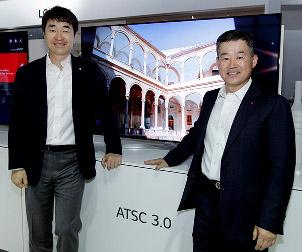'All' LG 4KTVs Sold in South Korea to Soon Feature ATSC 3.0

WASHINGTON—LG Electronics will include ATSC 3.0 tuners in all of its 4KTVs sold in South Korea beginning later this year, according to John Taylor, LG vice president of public affairs, who spoke during a panel discussion at the annual general meeting of the Advanced Television Systems Committee in the nation’s capitol this week.
“We’ll include our latest generation of ATSC 3.0 chip—it will include both 1.0 and 3.0 demodulation,” Taylor said.
LG introduced its first ATSC 3.0-enabled 4K Ultra HDTVs at CES in Las Vegas in January and said “new” 4K sets sold in Korea would include 3.0 tuners. Taylor today confirmed that would include “all” new 4KTV sets. LG 4KTV screen sizes range from 42 to 86 inches, Taylor said, and all LG TV sets over 50 inches are 4K. Commercial U.S. availability of the 3.0-enabled sets is contingent on the broadcaster roll-out plan in the United States, he said.
The Seoul-based manufacturer said it would roll out new big-screen smart TVs with both ATSC 1.0 and 3.0 tuning in anticipation of the 2018 Winter Olympics in Pyeongchang next February, which the South Korean government intends to cover in 4K.
In February of 2016, South Korean broadcasters announced their intention to start broadcasting in 3.0 this spring; and in July of last year, the Yonhap News Agency reported that South Korea’s Ministry of Science had adopted ATSC 3.0 as the official over-the-air TV transmission standard, making it the first country to do so.
“The early launching Korea is a really wonderful on-ramp for those of us in the United States,” he said. “We’ll build economies of scale on the production side.”
LG showed a 65-inch model at the January consumer electronics trade show, where they demonstrated broadcast video-on-demand and program guide delivery over the ROUTE protocol specified in ATSC 3.0. The manufacturer rolled out its dual-tuner chips at the 2016 NAB Show, most notably in a smart antenna designed to redistribute the 3.0 signals around the home via Wi-Fi. (TV Technology contributor Doug Lung provides more details on the tuner chip in, “Coming Soon: ATSC 3.0!,” June 22, 2016.)
LG has been actively involved in the development of ATSC 3.0 for years, first proposing “Futurecast” with Harris in 2013. (See “ATSC Receives 3.0 Physical Layer Proposals,” Sept. 6, 2013, and “OFDM-Based ‘Futurecast’ ATSC 3.0 Proposed by LG, Zenith and Harris Revealed,” Oct. 2, 2013.”)
ATSC 3.0 will be the first over-the-air TV transmission standard to leverage internet-protocol technology, which gives it new capabilities such as multiple audio tracks, 4K resolution, high-dynamic range and other advanced video features; portability to mobile devices and the use of apps among them. Development of ATSC 3.0 was first proposed in September of 2011 with the formation of TG3 within the ATSC.
TG3 was led by Dr. Richard Chernock of Triveni Digital, who continues to chair the group. ATSC 3.0 was perceived of before the development of 2.0 was completed in order to incorporate the work being done on mobile digital television. ATSC 2.0 comprised internet-enhanced broadcasting, non-real-time delivery and 3DTV, which evolved into 4K, HDR and other advanced video characteristics.
LG tested Futurecast in Madison, Wis., on WKOW-TV in October, 2014; and again in Cleveland in July of 2015. The foundation of the standard, referred to as the “physical layer,” was approved last year, with core technology contributions from LG and Zenith, it’s U.S.-based skunk works, including the scrambler, forward error correction, bit interleaver, mapper, time interleaver, OFDM framer, frequency interleaver, pilots, reserved tones, and guard interval functions.
LG also has been active in demonstrations of AWARN—the Advanced Warning and Response Network—the emergency alerting platform developed for ATSC 3.0.
~ James E.O'Neal contributed to this story.
For more TV Technology coverage of the standard and its development, see our 170-story ATSC 3.0 silo.
Also see the ATSC 3.0 Standards Update graphic for May 2017.
Get the TV Tech Newsletter
The professional video industry's #1 source for news, trends and product and tech information. Sign up below.
